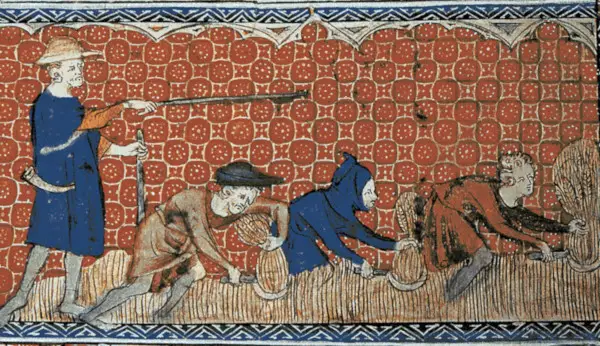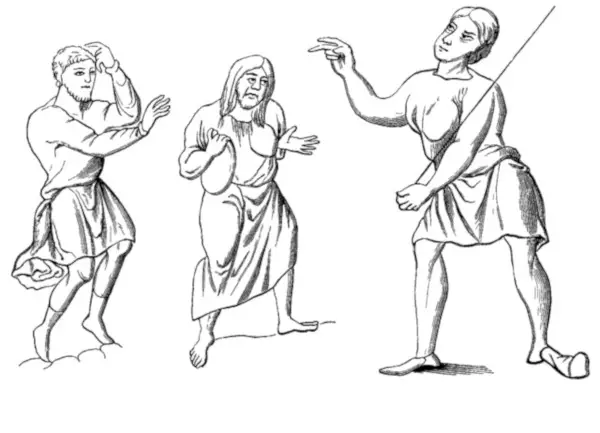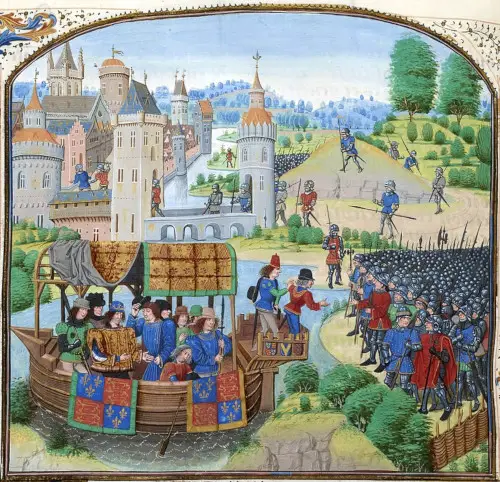Serfs in the middle ages were generally peasant farmers who provided manual labor in their master’s land.
The peasants would pay the lord some dues (in the form of labor) in exchange for using part of the lord’s land to generate their own food.
These farmers would work in the lands at least three times a week and sometimes longer during the plantation and harvest seasons.
The serf was bound to work in a single manor and his status as a serf was passed on to his children, who would then continue to work in that same estate, regardless of whether the land changed ownership.

Serfs harvesting wheat with reaping-hooks
Serfdom was introduced by the Roman Empire and most of the peasants in the Middle Ages were those who took over from their families who worked in Roman slavery.
In the Middle Ages, some freemen offered their freedom and labor to the lord in exchange for protection against the tides of war, diseases and poverty.
Nevertheless, serfdom was largely seen as an oppressive system that possessed characteristics of partial freedom and slavery.
Within the middle ages manor or village where the serfs lived and worked, there were further stratifications. The freemen did not owe labor to their lords but they paid rent in the form of agricultural products or money.
Other laborers included smallholders who would also rent very small pieces of land from the lord but they were not tied to the soil. At anytime these people would decide to become villeins and surrender most of their rights to the nobility or lords.
A villein or villain was the most common type of serf. Villeins had greater rights than the lower serfs. The lord allowed them to rent small houses but they would offer some of their time working in the lord’s manor.
They would spend the remaining time working in their own lands. There were other variations of villeins especially in middle ages Europe.
There were half-villeins who had access to very small pieces of land for their use and they owed their lord complete labor. This would force them to serve in other serfs’ pieces of land to compensate for the hardship.
Cottagers or small holders were lowers than the villeins because they only had access to small pieces of land, enough to feed a family. They were also not allowed to own horses or oxen while they lived within the enclosure of the manor.
Essentially the slave was his master’s possession and could be exchanged like a commodity. The only difference between a slave and villein was that the villein was not traded and he would not be dispossessed of his belongings.
However, villeins were of a lower status that a freeman because the lord did not permit the villein serf to marry someone outside of the manor, or change homes or donate his property.
The only way that a vellein would become free would be to run way to the city or a borough. But this would incur harsh penalties including losing land rights, paying a high price or loss of livelihood.
Daily Life of Serfs
For purposes of safety and defense, the serfs lived close together in small villages around their master. Other than working in the lands, the serfs were also dedicated to the Church.

Clothing worn by Serfs or slaves
The church played an important role in their lives as the serfs looked up to the Church for additional assistance in difficult times.
The serfs generously offered their labor and produce to their local church and were particularly instrumental in maintain the overall fabric of the church.
The day-to-day life a serf was difficult. In addition to the labor that he provided the lord, he also paid extra taxes for using facilities in the manor such as the mill. However, the lord was cautious not to lose his tenants by imposing too many obligations on the serfs.
Besides working on the lord’s demense, the serfs had limited access to non-arable land in the manor. The lord allowed them to graze their own cattle in the meadows and to cut some hay from there.
The serfs in the middle ages were also allowed to venture into the lord’s forests to gather firewood for building and domestic purposes.
Serfs in the middle ages had some form of political rights and were allowed to form their own village courts, known as halimotes. They created regulations and codes of conduct to be adhered to by the village members.
Their laws pertained to every aspect of village life including intermarriages, working in the fields, the role of women, festivities and celebrations. The courts typically comprised of 12 representatives who had the responsibility of enforcing the manorial laws.
The Decline

Richard II meets rebels during the Peasants’ Revolt of 1381
The system of serfdom saw a series of changes that went a long way in emancipating the serf. The Black Death was one such occurrence that killed almost half of the population in England.
This plague left very few people who could work in the field.
There was a greater demand for serfs and this opportunity was ideal for serfs to re-bargain the agreements they had with their lords.
As such, most serfs became freer and were not tied to the lord’s soil. Moreover, their serfdom was no longer something that their children inherited.
The Peasants’ Revolt of 1381 also contributed to the decline of serfdom in England. By 1500 the system of serfdom had was in complete decline but was still legal. Queen Elizabeth I freed the serfs who were still tied to their lord’s land.
A new system of copyhold tenancy emerged soon after this but was less restraining on the serfs as the earlier system. This system was however abolished in 1925. Other places that experienced peasant revolts were Sweden, Portugal, France and Germany.
Even though these revolts were usually successful, it was long before the countries changed the legal structures.
In places such as France, serfdom ceased by fact, when Philip IV, Louis X took over power in 1315. By the 15th century most of France was free of the system of serfdom even though it was still illegally practiced in a few areas across the country.
The nobles did continue to maintain privileges and rights over the freemen who worked in the nobles’ lands. In France serfdom was officially over in 1798.

Thanks this helped me with my medieval project a lot more than other sites!!!
This is a very useful website, keep it updated and people will come back to it.:-)
This was perfect for my SOSE ESSAY!!! Thankyou so much for the great Help!!! =D
this is really good to read for information to my project 😆 🙄
This helped me on my project
Perfect information! Keep it updated
😆 😀
Thanks, this really helped with my history homework!
This help me alot with my project for history and i did better than expected an A+ i did it thank yo
This helped me so much for a research paper were doing in English about the Middle Ages! Thanks!
Thanks this helped me with my medieval project on serfs.
this helped with my project
thanks!
You should add some information on what they wore
is medieal britain serfs in the middle ages